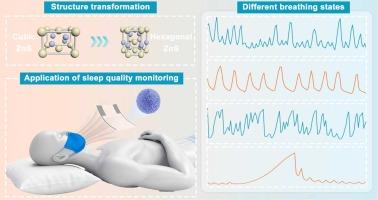Construction of high humidity-stabilized ZnS-NiS composites by NiS-induced phase transition: demonstrated for sleep quality monitoring
IF 3.7
1区 化学
Q1 CHEMISTRY, ANALYTICAL
引用次数: 0
Abstract
As a crucial electronic device in fields such as environmental monitoring, medical diagnosis, and smart homes, humidity sensors play a vital role in ensuring the efficient operation of relevant systems, with their accurate and rapid response performance being of paramount importance. Due to its distinctive electronic structure and hydrophilic properties, ZnS exhibits a rapid response to the adsorption and desorption of water molecules. This characteristic endows it with significant potential for applications in humidity-sensitive fields. However, most conventional synthesis methods yield cubic crystalline phase ZnS, which exhibits poor stability under high humidity conditions. The research in this work shows that introducing NiS induces a cubic to hexagonal phase transition in ZnS, effectively addressing poor stability of cubic ZnS. Meanwhile, the heterogeneous interface formed between ZnS and NiS generates a synergistic effect, optimizing the charge transfer path and efficiency within the material. When water molecules are adsorbed or desorbed, the charge transfer becomes smoother, making the material more sensitive to humidity changes. Finally, ZnS-NiS was coated on the interdigital electrodes to fabricate a flexible sensor. This humidity sensor demonstrates excellent long-term stability and a short response/recovery time (0.5 s/1.5 s), enabling precise monitoring of human breathing, including real-time tracking of breathing rate and sleep status (snoring, deep sleep, and light sleep). This work provides a new paradigm for designing stable and highly sensitive humidity sensors. Moreover, this synthetic method of this material holds significant reference value for the development of other gas sensing materials.

利用nis诱导相变构建高湿稳定的ZnS-NiS复合材料:用于睡眠质量监测
湿度传感器作为环境监测、医疗诊断、智能家居等领域的重要电子设备,其准确、快速的响应性能对保证相关系统的高效运行起着至关重要的作用。由于其独特的电子结构和亲水性,ZnS对水分子的吸附和解吸反应迅速。这一特性使其具有在湿度敏感领域应用的巨大潜力。然而,大多数传统的合成方法得到立方晶相ZnS,在高湿条件下稳定性差。研究表明,引入NiS可诱导ZnS从立方到六方的相变,有效地解决了立方ZnS稳定性差的问题。同时,ZnS和NiS之间形成的非均相界面产生协同效应,优化了材料内部的电荷转移路径和效率。当水分子被吸附或解吸时,电荷传递变得更平滑,使材料对湿度变化更敏感。最后,在数字间电极上涂覆ZnS-NiS制成柔性传感器。该湿度传感器具有优异的长期稳定性和较短的响应/恢复时间(0.5 s/1.5 s),能够精确监测人体呼吸,包括实时跟踪呼吸频率和睡眠状态(打鼾,深度睡眠和浅睡眠)。这项工作为设计稳定、高灵敏度的湿度传感器提供了新的范例。此外,该材料的合成方法对其他气敏材料的开发具有重要的参考价值。
本文章由计算机程序翻译,如有差异,请以英文原文为准。
求助全文
约1分钟内获得全文
求助全文
来源期刊

Sensors and Actuators B: Chemical
工程技术-电化学
CiteScore
14.60
自引率
11.90%
发文量
1776
审稿时长
3.2 months
期刊介绍:
Sensors & Actuators, B: Chemical is an international journal focused on the research and development of chemical transducers. It covers chemical sensors and biosensors, chemical actuators, and analytical microsystems. The journal is interdisciplinary, aiming to publish original works showcasing substantial advancements beyond the current state of the art in these fields, with practical applicability to solving meaningful analytical problems. Review articles are accepted by invitation from an Editor of the journal.
 求助内容:
求助内容: 应助结果提醒方式:
应助结果提醒方式:


